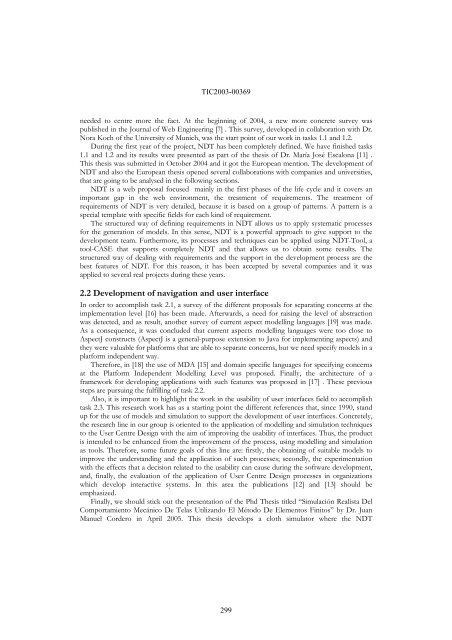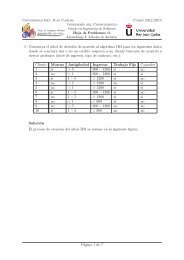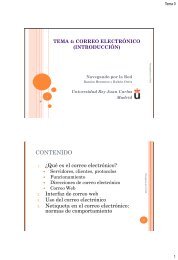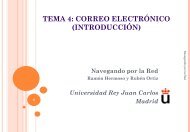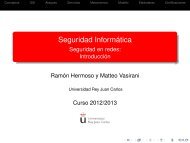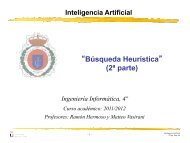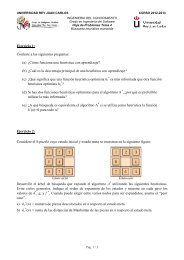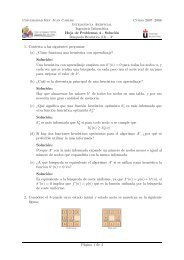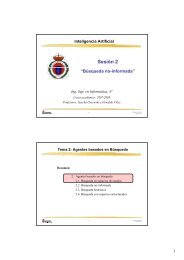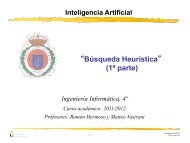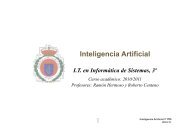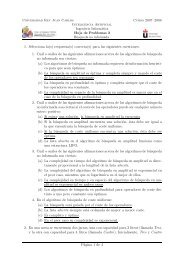GLIRS-II - Grupo de Inteligencia Artificial - Universidad Rey Juan ...
GLIRS-II - Grupo de Inteligencia Artificial - Universidad Rey Juan ...
GLIRS-II - Grupo de Inteligencia Artificial - Universidad Rey Juan ...
Create successful ePaper yourself
Turn your PDF publications into a flip-book with our unique Google optimized e-Paper software.
TIC2003-00369<br />
nee<strong>de</strong>d to centre more the fact. At the beginning of 2004, a new more concrete survey was<br />
published in the Journal of Web Engineering [7] . This survey, <strong>de</strong>veloped in collaboration with Dr.<br />
Nora Koch of the University of Munich, was the start point of our work in tasks 1.1 and 1.2.<br />
During the first year of the project, NDT has been completely <strong>de</strong>fined. We have finished tasks<br />
1.1 and 1.2 and its results were presented as part of the thesis of Dr. María José Escalona [11] .<br />
This thesis was submitted in October 2004 and it got the European mention. The <strong>de</strong>velopment of<br />
NDT and also the European thesis opened several collaborations with companies and universities,<br />
that are going to be analysed in the following sections.<br />
NDT is a web proposal focused mainly in the first phases of the life cycle and it covers an<br />
important gap in the web environment, the treatment of requirements. The treatment of<br />
requirements of NDT is very <strong>de</strong>tailed, because it is based on a group of patterns. A pattern is a<br />
special template with specific fields for each kind of requirement.<br />
The structured way of <strong>de</strong>fining requirements in NDT allows us to apply systematic processes<br />
for the generation of mo<strong>de</strong>ls. In this sense, NDT is a powerful approach to give support to the<br />
<strong>de</strong>velopment team. Furthermore, its processes and techniques can be applied using NDT-Tool, a<br />
tool-CASE that supports completely NDT and that allows us to obtain some results. The<br />
structured way of <strong>de</strong>aling with requirements and the support in the <strong>de</strong>velopment process are the<br />
best features of NDT. For this reason, it has been accepted by several companies and it was<br />
applied to several real projects during these years.<br />
2.2 Development of navigation and user interface<br />
In or<strong>de</strong>r to accomplish task 2.1, a survey of the different proposals for separating concerns at the<br />
implementation level [16] has been ma<strong>de</strong>. Afterwards, a need for raising the level of abstraction<br />
was <strong>de</strong>tected, and as result, another survey of current aspect mo<strong>de</strong>lling languages [19] was ma<strong>de</strong>.<br />
As a consequence, it was conclu<strong>de</strong>d that current aspects mo<strong>de</strong>lling languages were too close to<br />
AspectJ constructs (AspectJ is a general-purpose extension to Java for implementing aspects) and<br />
they were valuable for platforms that are able to separate concerns, but we need specify mo<strong>de</strong>ls in a<br />
platform in<strong>de</strong>pen<strong>de</strong>nt way.<br />
Therefore, in [18] the use of MDA [15] and domain specific languages for specifying concerns<br />
at the Platform In<strong>de</strong>pen<strong>de</strong>nt Mo<strong>de</strong>lling Level was proposed. Finally, the architecture of a<br />
framework for <strong>de</strong>veloping applications with such features was proposed in [17] . These previous<br />
steps are pursuing the fulfilling of task 2.2.<br />
Also, it is important to highlight the work in the usability of user interfaces field to accomplish<br />
task 2.3. This research work has as a starting point the different references that, since 1990, stand<br />
up for the use of mo<strong>de</strong>ls and simulation to support the <strong>de</strong>velopment of user interfaces. Concretely,<br />
the research line in our group is oriented to the application of mo<strong>de</strong>lling and simulation techniques<br />
to the User Centre Design with the aim of improving the usability of interfaces. Thus, the product<br />
is inten<strong>de</strong>d to be enhanced from the improvement of the process, using mo<strong>de</strong>lling and simulation<br />
as tools. Therefore, some future goals of this line are: firstly, the obtaining of suitable mo<strong>de</strong>ls to<br />
improve the un<strong>de</strong>rstanding and the application of such processes; secondly, the experimentation<br />
with the effects that a <strong>de</strong>cision related to the usability can cause during the software <strong>de</strong>velopment,<br />
and, finally, the evaluation of the application of User Centre Design processes in organizations<br />
which <strong>de</strong>velop interactive systems. In this area the publications [12] and [13] should be<br />
emphasized.<br />
Finally, we should stick out the presentation of the Phd Thesis titled “Simulación Realista Del<br />
Comportamiento Mecánico De Telas Utilizando El Método De Elementos Finitos” by Dr. <strong>Juan</strong><br />
Manuel Cor<strong>de</strong>ro in April 2005. This thesis <strong>de</strong>velops a cloth simulator where the NDT<br />
299


